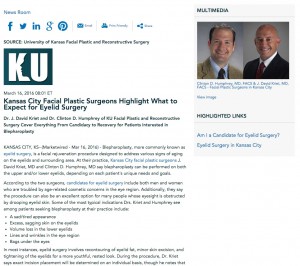
Dr. J. David Kriet and Dr. Clinton D. Humphrey of KU Facial Plastic and Reconstructive Surgery cover everything from candidacy to recovery for patients interested in blepharoplasty.
Kansas City, KS — Blepharoplasty, more commonly known as eyelid surgery, is a facial rejuvenation procedure designed to address various signs of aging on the eyelids and surrounding area. At their practice, Kansas City facial plastic surgeons J. David Kriet, MD and Clinton D. Humphrey, MD say blepharoplasty can be performed on both the upper and/or lower eyelids, depending on each patient’s unique needs and goals.
According to the two surgeons, candidates for eyelid surgery include both men and women who are troubled by age-related cosmetic concerns in the eye region. Additionally, they say the procedure can also be an excellent option for many people whose eyesight is obstructed by drooping eyelid skin. Some of the most typical indications Drs. Kriet and Humphrey see among patients seeking blepharoplasty at their practice include:
- A sad/tired appearance
- Excess, sagging skin on the eyelids
- Volume loss in the lower eyelids
- Lines and wrinkles in the eye region
- Bags under the eyes
In most instances, eyelid surgery involves recontouring of eyelid fat, minor skin excision, and tightening of the eyelids for a more youthful, rested look. During the procedure, Dr. Kriet says exact incision placement will be determined on an individual basis, though he notes that incisions for upper and lower blepharoplasty are generally made along the natural creases of both eyelids in order to help conceal any potential scarring. For some lower eyelid surgery patients, he adds, a transconjunctival approach may be utilized to hide the incision inside the eyelid.
Regarding recovery from eyelid surgery, Dr. Humphrey says patients can typically expect some minor swelling and bruising, but he notes these postoperative effects can often be diminished by keeping one’s head elevated and applying cold compresses to the eye region during the initial stages of healing. While some individuals are able to resume their normal daily routines within a week of surgery, he states the majority of patients make their return to work/public after about seven to ten days.
About J. David Kriet, MD, FACS
Dr. Kriet earned his medical degree from the University of Oklahoma College of Medicine prior to completing his Otolaryngology Residency at the University of Washington, Seattle and his Facial Plastic and Reconstructive Surgery Fellowship at Oregon Health and Sciences University. In addition to being a Fellow of American Academy of Facial Plastic and Reconstructive Surgery, he is a Diplomat and Senior Examiner of the American Board of Facial Plastic Surgery as well as a Diplomat of the American Board of Otolaryngology.
About Clinton D. Humphrey, MD, FACS
Dr. Humphrey earned his medical degree from the University of Missouri School of Medicine before completing his Otolaryngology Residency at the University of Kansas Medical Center and his Fellowship in Facial Plastic and Reconstructive Surgery at the University of Illinois-Chicago Medical Center. In addition to being certified by both the American Board of Otolaryngology and the American Board of Facial Plastic and Reconstructive Surgery, he is a member of the American Academy of Facial Plastic and Reconstructive Surgery, the American Academy of Otolaryngology, and the American Medical Association.
Drs. Kriet and Humphrey are available for interview upon request.
For more information, visit kufacialplasticsurgery.com.
Contact:
University of Kansas Facial Plastic and Reconstructive Surgery
KU Medical Center
3901 Rainbow Blvd.
Kansas City, KS 66160
KU MedWest
7405 Renner Rd.
Shawnee, KS 66217
(913) 871-9785
Rosemont Media
858-200-0044
www.rosemontmedia.com

Comments are closed.